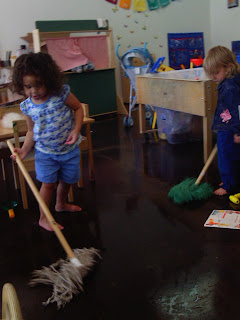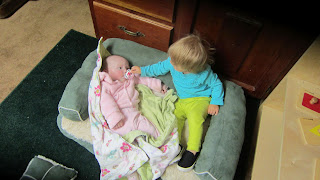I can't count the times this week I've heard, "So you're not teaching any more?" when individuals learn we've begun accepting infants. Actually, we've found we have more opportunities to teach...and not just the older children. Maria Montessori described various "sensitive stages" for learning. These stages started from birth, thus Montessori believed that education should start from birth. We share this same belief at Riverwoods Learning Center.
From birth throughout the child's first year there are two major areas of development--movement and language. As early 1-2 months a child begins to learn the complex concept of cause and effect. When they move their hand into an object the object moves. At this point the child is ready for simple grasping and reaching exercises and the introduction of simple toys such as the grasping beads.

Children at this age also need freedom of movement. This is why we limit the "baby holders" in our infant environment and focus on giving the infants--even those who are not yet quite "mobile"--time on the floor to move freely. Montessori was opposed to the use of objects such as swings and walkers, which limit a child's ability to move their body naturally and often puts them in unnatural positions before they are able to truly support themselves. While we've found with multiple infants sometimes these "baby holders" are a life saver, we limit their use as much as possible. Montessori also encouraged the use of a simple "floor bed" known as a topponcino, a simple mat on the floor. I've found the toppocino has the added benefit of extra support while holding an infant that needs comforting, and it is easier to transfer a sleeping infant from arms to the floor or pack 'n play (necessary again in an environment where a sleeping child can easily be tripped over).

Having an infant in a mixed age group also provides the opportunity for older children, even toddler-aged little ones, to develop empathy and an understanding of the needs of others.
So through the simple provision of time and a child-centered environment we're developing cause & effect, fine motor and gross motor development skills, self help skills, social competency, language and literacy skills, etc. I'd say that fits into the definition of "teaching" as far as I am concerned!









